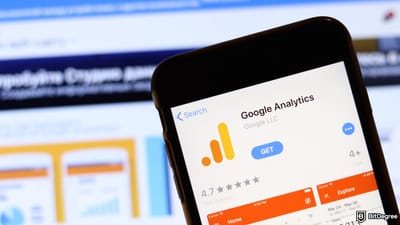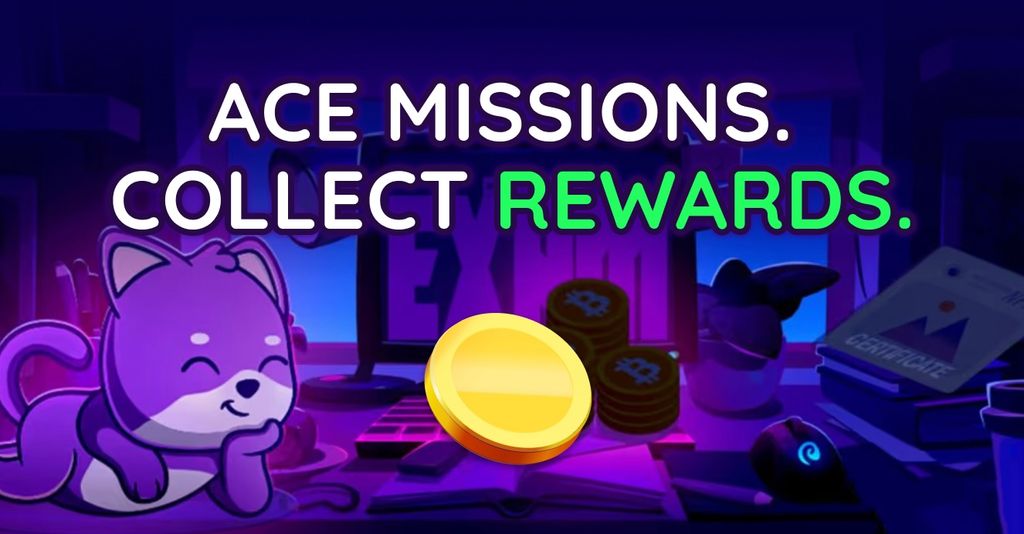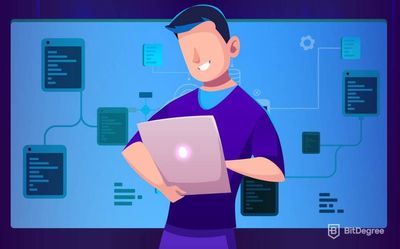Ace quick missions & earn crypto rewards while gaining real-world Web3 skills. Participate Now! 🔥
The idea of virtual learning isn’t new. It first emerged in the form of corporate training courses in the mid-1990s[1]. In those days, it was still rather primitive and really not that effective. Though it has come a long way since then.
Even before the pandemic, the overall market for online education was projected to reach $350 Billion by 2025. Surprise, surprise - the COVID-19 outbreak accelerated online learning trends even further. According to a 2020 article by UNESCO, school or university closures had affected around 1.3 billion learners[2].
With schools and universities shut - virtual learning became the only viable solution. With many people in lockdowns and more free time on their hands, the popularity of online courses skyrocketed. Whether it is language apps, virtual tutoring, video conferencing tools, or online learning software, COVID-19 fueled their usage. Not everyone is supportive of this new shift, but more about that later.
In this article, we’ll answer questions like what is virtual learning? What are the good and the bad sides of it? How does it affect students? teachers? Will it really replace traditional classes? How effective is it? What about the virtual learning environments?
Ready? Let’s dive into it!
Table of Contents
- 1. What Is Virtual Learning?
- 2. Virtual Learning: the Good and the Bad
- 2.1. Benefits of virtual learning
- 2.2. The Not-So-Great Things About Virtual Learning
- 3. Online Learning: People Want It, People Need It
- 4. Interactive Virtual Learning
- 5. Is Virtual Learning Effective?
- 6. How Can I Use Virtual Learning To My Advantage?
- 7. The Best E-Learning Platforms and Popular Programs
- 7.1. Udacity
- 7.2. Datacamp
- 7.3. Udemy
- 8. Will Virtual Learning Replace In-Class Education?
- 9. Conclusions
What Is Virtual Learning?
Today, we’ll explore the phenomenon of virtual learning - a method of education that is most likely here to stay, whether we like it or not. If you’re not a fan - perhaps this article will help you see the positive side to it. After all, it’s a type of learning that can remove barriers of time and space imposed by the traditional in-class system. Of course, virtual learning also has its downsides, but more about that later.
Latest Deal Active Right Now:Take advantage of this special Udacity coupon code & access selected Udacity courses for free! Learn new skills & develop your career at zero cost.
Right now, let’s make sure we’re on the same page as to what virtual learning means. So what is virtual learning? Many use online learning, e-learning, virtual learning, and web-based learning interchangeably. Whatever term you choose, one thing is for sure - virtual learning is something that goes beyond online courses (although online courses are a big part of it).

Think of virtual education as an educational environment, a virtual space where students and teachers interact by using electronic communications tools. Virtual learning is an element of virtual education, it is the process of learning facilitated by the internet and other electronic tools[3], as well as virtual learning environments (VLEs).
Meanwhile, a Virtual Learning Environment is “a system for delivering learning materials to students via the web[4]. These systems include assessment, student tracking, collaboration, and communication tools.”
Virtual Learning: the Good and the Bad
Okay, so it’s no secret that virtual learning is frowned upon by many - especially those who view it as some artificial world that sweeps away real-life traditions without a trace. However, that’s not necessarily the case.
Yes, education did move pretty much entirely to virtual classrooms during the pandemic, but this wasn’t entirely planned or voluntary. Such a rapid switch from one mode to another was a shock to many students and teachers, which added to their negative perception of virtual learning.

However, we can’t ignore the potential it has to make online and in-class learning more effective and available for many, among other benefits.
Sure, it’s not all perfect. These turbulent times have brought to surface the strengths of virtual learning and helped us realize the potential that it has, but it also revealed the not-so-good things about it.
Here’s a summary of the drawbacks and the benefits of virtual learning:
| Benefits | Drawbacks |
|
|
|
|
|
|
|
|
|
|
|
|
|
|
|
The factors in these columns affect students and teachers, although it’s true that some may be more relevant to one group than the other. Let’s have a look at the drawbacks and benefits of virtual learning in more detail and explore the implications they may have for both sides of the equation: those who learn and those who teach.
First, let’s look at the good side of virtual learning.
Benefits of virtual learning
- Removes Barriers of Time and Space
Because virtual classes are not restricted by physical space, they provide a lot more freedom to students as well as teachers. The information can be provided and accessed from pretty much anywhere with an internet connection and a computer.
- Flexibility
Because virtual learning can remove barriers of time and place, it becomes very flexible, especially for students. Often, students can choose their own time to study and go at their own pace. The possibility of taking classes in a virtual learning environment allows those who have a job to combine work and study.
Meanwhile, in a school environment - students who aren’t able to attend class for one reason or another, could log in to a virtual classroom and avoid falling behind[5].
Also, perhaps not in schools, but in the case of open online courses, many lectures are pre-recorded, so students have the freedom to choose when and for how long they want to study - a very attractive factor to many.
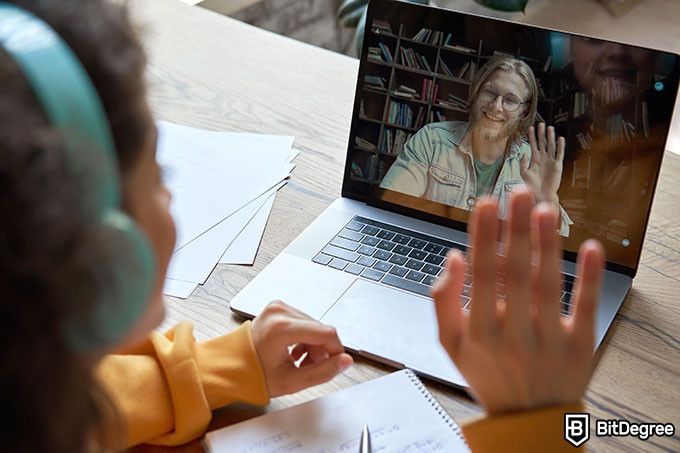
- Quality
Many people seem to doubt whether online learning can provide high-quality content. I mean face-to-face learning has been the standard for centuries, and humans are naturally wary of drastic changes, so I guess that may be the reason.
However, as we’ll see later on in this article, virtual learning does not equal lower quality education. As with anything else, of course there are some courses that aren’t all that great, but that’s also the case with traditional classes.
In fact, many well-known universities like the Imperial College London, Harvard University, University of Michigan, and many more have embraced virtual learning by offering university-level courses and programs on a huge variety of subjects on top e-learning platforms. These platforms are known for consistently providing high-quality content that benefits students across the globe.
What’s great about online learning is that all of the information about various courses can be found on the internet, so you can easily access experts’ reviews, and other students’ feedback on the courses and programs that you’re interested in, this way making sure you don’t choose a ‘bad’ one.
- Limitless Online Training
There is a long list of companies offering online courses to students and fulfilling their various needs - from personalized classroom teaching to preparing for competitive exams and earning professional certificates.
You can gain skills in pretty much anything: from child nutrition to programming or physics. There are literally so many options to choose from. For example, Udacity offers online courses in programming, data science, artificial intelligence, and other digital skills with industry-specific assignments so that students are ready to work in the field after completing those courses. This is ideal if you want to advance your career, but aren’t ready to quit your current job just yet.
Anyway, I'll tell you more about different platforms and the type of courses you can find in the next section of the article.
- Facilitates Administrative Tasks
Virtual learning environment can be an efficient way to carry out administrative tasks. You just have to know what tools to use.
It can take a fair amount of stress off of teachers' and tutors’ shoulders, as they don’t have to worry about carrying around all the paperwork. It also makes organizing the work a lot more simple.
- Cost-Effective
Higher education is very expensive in many countries. Virtual learning is an opportunity for students to save up, and for teachers - to earn more by reaching more students.
For example, one of the most popular Professional Certificate Programs by Harvard University is Professional Certificate in Data Science on edX. It’s made up of 9 different courses that altogether take just about over a year to complete. Guess how much it costs. The full program experience price is around $980! No hidden fees.
On top of that, as a way to promote the courses, many platforms offer coupons that can often save a ton of money while giving students full access to all the content and certificates. You can even complete a fully-fledged master’s or bachelor’s degree on Coursera for about $9,000 - in many institutions, that covers only about one semester or one academic year at best.
Plus, not having to commute is financially beneficial for everyone, it saves a lot of time, and that’s not all! Another reason why virtual learning is cost-effective is that students usually don’t have to purchase any textbooks and course materials like they do in traditional classes, because virtual coursework takes advantage of virtual resources[6].

- Bigger Variety of Options
Virtual learning allows students to access content that may not be otherwise available where they live. Students don’t have to rely on the resources of the local institutions. This opens many doors - practically any skill is at your fingertips. Likewise, teachers and tutors can share their knowledge with a much larger audience.
For example, Udemy is one of the most popular e-learning platforms in the world right now (more about it later), with more than 50,000 instructors offering more than 130,000 courses in over 60 languages. How many students? Around 35 million! Can you think of a single institution offering that many in-class courses?
- Permanence
All the tasks and content are stored online, which means students can access, study, and analyze it at any time. For teachers, it’s safe having a sort of register of all the work and lesson transcripts that they can access whenever. Because all the information can be accessed easily at any time, it can actually help improve virtual learning over time, as teachers can learn from lesson transcripts too.
The Not-So-Great Things About Virtual Learning
- Digital divide
While it’s true that virtual learning is easily accessible to many, it wouldn’t be fair to say that anyone can access it at any time. We would be ignoring the digital divide.
There are people who cannot reap the benefits of virtual learning because they cannot afford technology and broadband access in the first place, while others lack the skills to engage with learning technology.[7]
Only those who have the right ecosystems can truly make the best of online classes.
- It can be less social
In-class learning ensures immediacy, personal contact, and community - factors that virtual learning sometimes lacks. However, that’s not to say that it cannot be improved. There are some highly interactive platforms, you just have to know where to look. I’ll tell you more about that later.
- Requires self-discipline
In traditional learning, just going to class seems enough to get into the right mindset, however, in virtual learning, you don’t even really need to get up to go to class. That is, you have nothing and no one really to motivate you and ‘force’ you to go online in that sense. So you need to use all the motivational resources. Well, at least it’s a chance to work on yourself and force yourself to finish what you’ve started. Practise makes perfect, hey?

- No sense of place
Schools and universities provide a physical space that is dedicated and built around learning activities, both social and cognitive. That creates a unique teaching and learning environment. So we could say a school or a university is a place where students' and teachers’ needs are supported, and so this gives them a sense of place when they are physically in school or on campus.
That physical place vanishes when it comes to virtual learning. However, more and more technological tools are being integrated to help create a sense of place for online students. They make it easier for students and teachers to interact in ‘one place’, and exchange all the information and materials there, in this way facilitating social interactions and fulfilling those needs[8].
Online Learning: People Want It, People Need It
So in terms of schools and universities, not everyone has been very excited about moving 100% to virtual learning - and that’s understandable. Those who signed up for face-to-face interactions, community, and social student lifestyle, aren’t keen on spending their time behind computer screens instead.
The same goes for teachers, who have had to drastically change their teaching methods without much preparation - shout out to all those heroes out there, it must have been pretty stressful.

However, there’s a whole other segment of the population, who welcome virtual learning with open arms. Online courses to them are an amazing opportunity to gain all sorts of skills and knowledge that wouldn’t otherwise be accessible - it can literally be life-changing.
As I mentioned at the beginning of the article, the market for virtual learning has been growing for some time now, but the pandemic really gave it that extra push. Without numbers it’s hard to picture the scope, so here’s some easy-to-digest data for you:
Enrollment at Coursera – an online platform that offers MOOCs was 640% higher from mid-March to mid-April than during the same period last year, growing from 1.6 to 10.3 million. Enrollment at Udemy was up over 400% between February and March.
Interactive Virtual Learning
Virtual learning doesn’t have to be isolated, lonely, or monotonous. With all the tools and technology available, we can create a truly interactive learning experience even online.
Some e-learning platforms, including Udacity, Datacamp, edX offer virtual learning environments that are interactive. Real-life projects, Github access, peer reviews, instructor comments, quizzes, discussion panels, facebook groups - are part of the virtual learning process.
Is Virtual Learning Effective?
It certainly can be. Of course, it all depends on how we use it. We can’t simply take our traditional ways and move them to virtual space hoping it’ll work just as well. Virtual learning has a lot of potential to make learning more efficient, but we have to come up with new ways to really make it work.
One of the ways to ensure virtual learning is effective is to make it interactive. After all, “interacting with other people has proven to be quite effective in assisting the learner to organize their thoughts, reflect on their understanding, and find gaps in their reasoning[9].”
More e-learning platforms and other institutions that are moving to virtual learning should follow in the footsteps of innovative platforms like Udacity or Datacamp.
How Can I Use Virtual Learning To My Advantage?
Perhaps there’s a skill you’ve always wanted to gain? A subject you’ve wanted to explore? A language to learn? With so many affordable online courses out there, the only thing you need to achieve any of those is motivation!
You can use virtual learning and online courses to:
- Advance your career
- Learn new skills
- Form connections
- Access all kinds of knowledge and content
- Practice real-life scenarios
- Expand area of expertise
The Best E-Learning Platforms and Popular Programs
Since we’ve talked a lot about virtual learning and the benefits it can bring, I feel it’s my duty to share with you some e-learning platforms and the most popular courses that are available right now. Perhaps you’ve been thinking about taking an online course, or just want to see what it’s like - these platforms have a lot to offer.
So, I’ll give you a list of a few e-learning platforms that have courses on a huge variety of topics, organized by well-known universities and experts in their field. I won’t tell you about all the courses there are because that would take me hours (or even days). Instead, I’ll tell you what courses are trending right now on each platform.
Let’s take a look.
Udacity
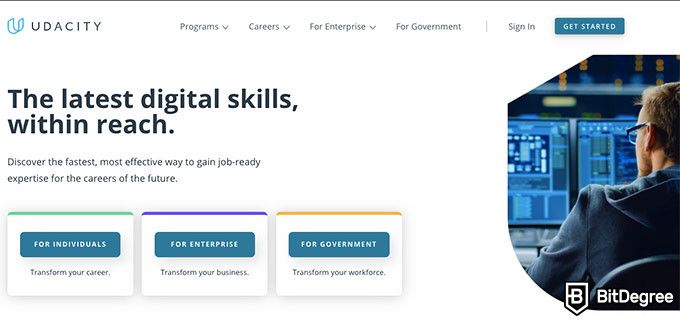
Udacity started its online activity in 2012 with courses on building search engines and robotics. Since then, the scope of the courses they offer hasn’t stopped expanding, although their courses mainly center around in-demand tech-skills. Originally it was all about university-style courses, but recently they switched their focus to vocational programs for professionals.
One of the most popular programs on Udacity is Become a UX Designer Nanodegree, developed for aspiring UX designers who study a series of courses at their own pace, and build job-specific skills as they go along. One of the most amazing and useful things about this program is that students actually get to build a portfolio of real-world projects that have to be completed at the end of each course within the program.
Datacamp
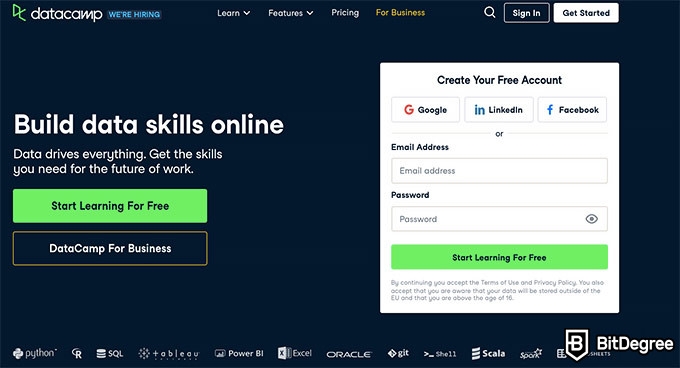
Founded in 2013, it’s easily one of the most important e-learning platforms in the fields of Data Science and Programming at the moment. Their list of courses, the design of their programs, practical exercises, and the interface make it one of the best sites ever. More than 3 million students are using it to learn job-specific skills through the Datacamp website and app.
Datacamp offers single courses as well as career tracks which are combinations of courses that ¨help you learn all you need to start a new career in the data science field¨. Perhaps the statement is slightly exaggerated, but careers tracks are actually a good way to build a solid foundation in the field that students can build upon.
One program that attracts a lot of attention is Data Scientist with Python Career Track. According to Datacamp, it will teach you to use this versatile language (Python) to import, clean, manipulate, and visualize data - all integral skills for any aspiring data professional or researcher.
Like with courses on Udacity, Datacamp incorporates many projects that imitate real-life scenarios, so students actually get to practice relevant skills. In this specific Career Track, you get a chance to work with real-world datasets in order to learn statistical and machine learning techniques.

- Easy to use with a learn-by-doing approach
- Offers quality content
- Gamified in-browser coding experience
- Free certificates of completion
- Focused on data science skills
- Flexible learning timetable

- High-quality courses
- Nanodegree programs
- Student Career services
- Nanodegree programs
- Suitable for enterprises
- Paid certificates of completion

- A wide range of learning programs
- University-level courses
- Easy to navigate
- University-level courses
- Suitable for enterprises
- Verified certificates of completion
Udemy

Founded in 2010, right now Udemy is by far the largest online learning platform in the world.
It’s slightly different from other platforms here because on Udemy, it’s not organizations that design the courses, but individuals with expertise in a certain field. Still, there are some courses organized by groups of people or institutions, but it’s less common.
All the courses on this platform have to be approved by Udemy’s team. However, some lower-quality courses sometimes still get through, but it’s not really a major issue because you can always read other students’ reviews, watch course previews and check out the content before enrolling.
I won’t go into too much detail, but there are more trustworthy e-learning platforms that offer university-level courses at an affordable price. All the courses on these platforms are actually organized by well-known universities including Harvard University, University of California, University of Michigan, Stanford University and many more.
If you’re interested, check out these platforms:
There are courses and programs on pretty much anything. You can study the science of wellbeing in this course, learn how to learn online with the Learn How to Learn Online Course, learn more about psychology with Introduction to Psychology, or gain skills in COVID-19 Contact Tracing (actually a very popular course right now).
Virtual learning really is a ‘land’ of opportunities - it can help you gain the skills you want and learn about subjects that you haven’t even thought of yet!
Who knows, maybe you’ll find a new passion or learn something that will change the way you think! Here’s something you may find exciting: many courses on edX and Coursera can be accessed for free (for real!). So if you want to learn more about something, 2023 is a good time to satisfy that curiosity.
Will Virtual Learning Replace In-Class Education?
Hardly. At least not anytime soon. This is because both virtual learning and traditional learning have unique characteristics that benefit the education processes. Why should we abandon one way for the sake of the other? Why not take the best from both and create something new?
Having said that, the integration of IT into education is likely to grow in the foreseeable future. Perhaps it won’t go so far as to replace the conventional type of learning in schools, but it’s not far-fetched to think that virtual learning will become an integral part of traditional classroom-based education.

I also think we shouldn’t steer away from virtual learning because we’re worried it will replace real-life classrooms. There’s value in traditional learning, it brings many benefits that we enjoy and benefit from: face-to-face interactions, real-time knowledge, the community, sense of place, healthy competition, and so on.
On the same note, there’s a lot to be gained from incorporating virtual learning and virtual learning environments into our conventional systems, because of all the benefits we looked at earlier on.
BW Education has described ‘blended learning’ as the future of learning. This type of learning essentially combines face-to-face learning to create a new, more effective system of education that has the best of both worlds. This type of learning is already being implemented by schools and universities.
Alternatively, those who find 100% online education convenient and beneficial will choose virtual learning that takes place entirely in a virtual space, which is a more accessible and affordable way of acquiring new skills and knowledge.

Did you know?
Have you ever wondered which online learning platforms are the best for your career?
Conclusions
So today we explored virtual learning, which is the process of learning facilitated by the internet and other electronic tools. Virtual learning isn't just online courses - it also involves virtual classrooms and virtual learning environments. It also doesn't have to be 100% online - virtual learning can be integrated into traditional education, according to the circumstances.
Like anything else, virtual learning comes with its own set of benefits and drawbacks. It can remove the barriers of time and space, however, it also perpetuates the digital divide.
Virtual learning doesn't imply lower quality than traditional learning. There are some e-learning platforms that offer university-level courses in collaboration with some well-known universities, including Harvard and Stanford Universities.
Other platforms such as Datacamp and Udacity are also top-quality digital skills course providers. Hundreds of thousands of students have taken their courses - it isn't hard to find many positive testimonies.
All in all, virtual learning can be a great addition to traditional learning, but it's not likely to replace it altogether. At least not anytime soon. While it is a highly attractive option for many, because of its convenience and opportunities available - there are also many benefits to be gained from traditional learning. Nevertheless, virtual learning opens up a world of opportunities that many never even thought was possible - that's something to appreciate!
Scientific References
1. Lezli Kubo, The Rise of Online Education: Exploring the Phenomenon, 2019
2. World Economic Forum: The COVID-19 pandemic has changed education forever, 2020
3. Kerimbayev Nurassyl, Virtual Learning: Possibilities and Realizations
4. Oxford University Press: What is VLE?
5. Claudiu Coman, Laurențiu Gabriel Tîru, et al: Online Teaching and Learning in Higher Education during the Coronavirus Pandemic: Students’ Perspective, December 2020
6. Drexel University: The Benefits of Online Education in a Virtual Classroom
7. AIS E-Library: E-Learning and the Digital Divide: Perpetuating Cultural and Socio-Economic Elitism in Higher Education
8. AIS E-Library: Sense of Place in Virtual Learning Environments
9. Springer, Boston, MA: Social Interactions and Learning


